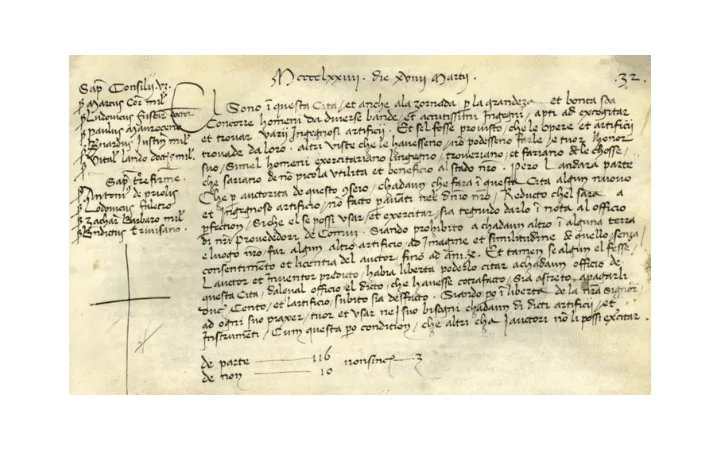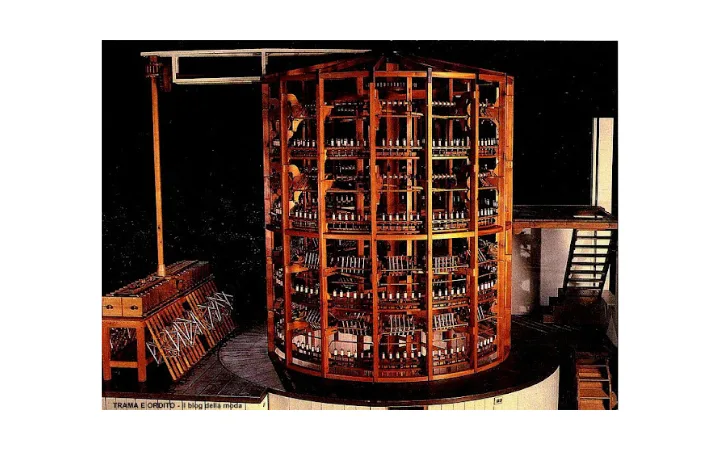Old IP Rights for Today’s SMEs in the IT sector

The third in the IP for SME series, I look back on some of the earliest records of what could be considered Intellectual Property rights being exercised. #
Let’s begin with a bit of history.
Part I: Venice, 2nd half of the XV century. #
At the time, Venice was what nowadays we would call a superpower. After the voyages of Marco Polo to China, the Republic was a true bridge between the West and the East; a crossroad of wares, people and of course ideas and technologies.
The city itself was a technological challenge: building a high-rise palace on water was not a trivial feat, and the canals had to be continuously dredged; the unbeatable fleet also had to be continuously refurbished and made ever more competitive against the Arabs and Turks. In short, technology and continuous innovation were key not only to success, but even just to survive.
Attracting Innovators #
Venice was ruled by an oligarchy of nobles and merchants sitting in the Senate, who soon realised how important it was to attract the best minds of Europe to the Lagune, to foster innovation and so underpin, nurture, and further develop the supremacy over the commercial routes of the Mediterranean.
One such example of attracting such innovators, were the brothers Johann and Wendelin of Speyer. Goldsmiths in Mainz, Germany, in 1468, the brothers set out for Italy and established a new business (an SME) in Venice: printing books using the printing process invented a few years earlier (around 1436) by another German goldsmith, Johannes Gutenberg. For his print, he invented an antique type modelled after the best Italian manuscript writing, which was of unprecedented beauty and skillful cut.
Protection of Inventions #
This presented a wonderful occasion for the Senate to test a new idea: protecting innovations; and in 1469 Giovanni da Spira (Johann’s Italianized name) was granted the exclusive right to use his idea over the whole territory of the Serenissima.
Just a few short years later, on the 19 March 1474, the Senate issued the first Statute on the protection of inventions: it foresees, among other features; the concepts of novelty and inventiveness, reduction into practice, disclosure, territorial scope of protection, licensing, patent term (10 years, but life expectation in those times was much shorter…), infringement action, compensation for damages and court orders. From the statute:
“Wherefore it shall be taken as a party that, by authority of this Council, everyone who shall make in this city some new and ingenious artifice not previously made in our dominion, conducted which shall be to perfection, so that he may use and (practically) exercise it, shall be bound to record it at the office of our City Provosts. Being forbidden to anyone else, in any of our lands and localities, to make any other artifice in the image and likeness of the (original) one, without the consent and license of the author, until the term of 10 years. And nevertheless, if any one should do so, let the aforesaid author and inventor have the liberty of being able to cite him to some office of this city; from which aforesaid office, who had counterfeited (the work), let him be compelled to pay him one hundred ducats, and the artifice at once be undone.”
Looking at all of these included elements, it is hard to see anything missing compared with today’s intellectual property laws.

Part II: Let’s rewind history a little more, III century BC, but remaining in Italy. Sibarys, Calabrian coast on the Ionic sea. #
A Sibarite law of the III century BC provided that whoever, cook or assistant , invented a new and original recipe had for one year the exclusive right on its reproduction .

The law, as quoted states:
"The Sybarites established by law that if a cook or assistant had invented an original and elaborate recipe, no one other than the inventor had the right to reproduce it before the term of one year, and that during this period he alone had exclusion of reproduction, so that others, engaging themselves, would accelerate with similar inventions”.
See the book by my uncle Placido Scaglione, former Head of IP and Licensing at Enichem, “Il Brevetto di Sibari e le Anticipazioni Storiche della Gente di Calabria”, Franco Pancallo Editore, Locri, 2008. He is credited also with the translation into Italian, no DeepL or Google Translate at that time!
Ok, it’s a recipe (we are in Italy after all!), but for the rest … the recipe had to be NEW and ORIGINAL: doesn’t this sound like a copyright?
Part III: Bologna, XIV century #
The "Bolognese-style" spinning wheel, used for the production of silk threads, possessed two unique features that made them extremely efficient and qualitatively superior. Firstly, it was driven by a water wheel and not by hand, and secondly, during the spinning operation, it transferred the threads onto spools and not onto reels.

The industrial secret for the construction of these complex machines was closely guarded within the city of Bologna, although over the centuries numerous attempts were made to take the know-how away from the entrepreneurs by luring out of town the technicians and workers of the industry.
Modern day legislation would recognise this as a trade secret.
Part IV: Present day #
What was conceived centuries ago to protect know-how is today’s choice for those who wish to protect their inventions, especially in the IT sector:
- Software copyright covers the specific code used in the program or elements in the user interface. Copyright is automatically obtained by the creation of the original work, there’s no need to go through an application process;
- Software patents protect aspects of IT products that cannot be protected otherwise, as long as they have technical character;
- A trade secret is know-how that is not publicly available and is kept secret by its owner. Trade secrets are protected by law if the owner makes a reasonable effort to keep it a secret: it’s obviously illegal to steal a trade secret, but reverse engineering or autonomous development are, of course, permitted.
Whilst the idea of protecting intellectual property isn't a new one, the importance of having robust and detailed IP strategies in place is continually growing. To find out how Murgitroyd can help you and your business to maximise your IP potential, contact us.




















